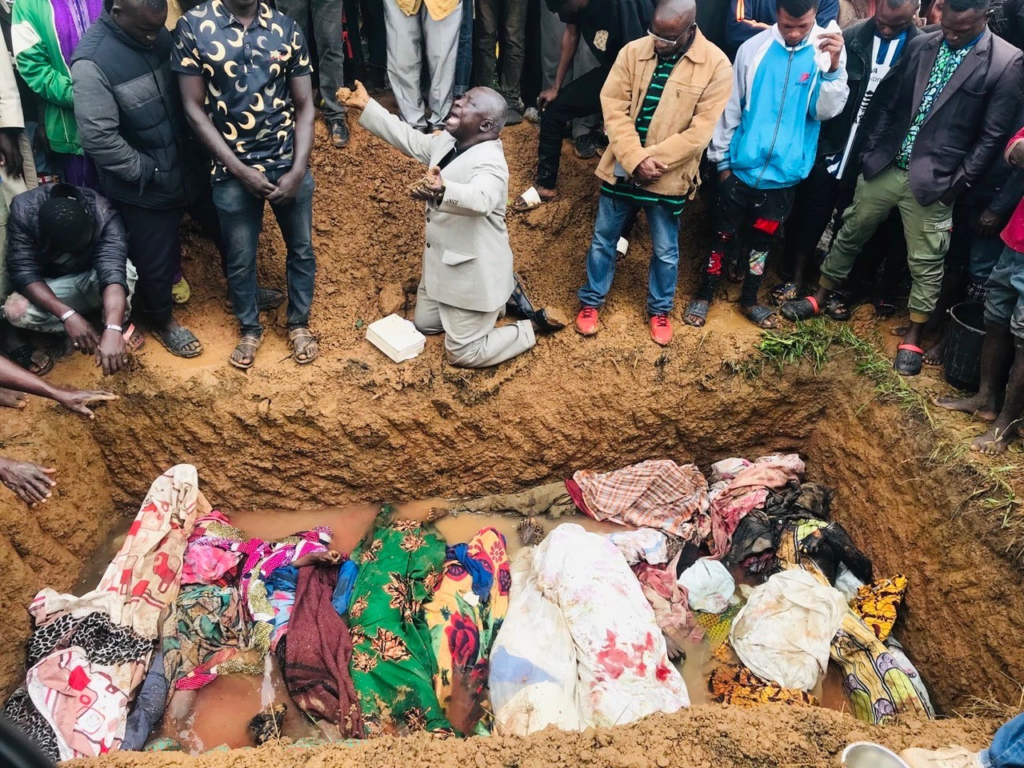CHIBOK SPECIAL 10TH ANNIVERSARY REPORT

By Emmanuel Ogebe, Esq.
Sunday, April 14 was the tenth anniversary of the kidnapping of 276 teens at the Government Girls Secondary School in Chibok, Borno State by Nigerian jihadists Boko Haram. Terrorists forced the girls into trucks and drove them through forest trails to a 128,000 acre forest. At least 57 of the girls escaped at the outset by jumping off the trucks during transport. Others have been rescued by the Nigerian armed forces. One girl escaped almost miraculously on her own in 2016. The cause of rescuing the kidnapped girls was escalated by First Lady Michelle Obama who popularized the slogan, “Bring Back Our Girls!” That widely promoted slogan promoted solidarity between the people of Nigeria and the people of the United States in a way that was unprecedented, and which hasn’t been repeated by any Administration since then.
According to the book “The Sisterhood: The Secret History of Women at the CIA” by Liza Mundy, (Published by Crown
Oct 17, 2023 | 480 Pages ) the CIA rescued 30 Chibok girls in 2016, but regrettably, the story lacks credibility.
Here are 10 reasons why:
1. “276 female students had been kidnapped from a Christian boarding school in Chibok”
One thing universally known about the school is that it was a “Government Girls Secondary School.” It literally says so on the name! It was not a “Christian boarding school.” In fact the US government at the time was intentionally denying the persecution of Christians in Nigeria. How is it possible that the CIA which publishes a world acclaimed fact file got a notorious fact that even Wikipedia reports correctly so wrong?
2. “Boko Haram at that time was an ad hoc and strident boys’ club, a homegrown group of religious extremists opposed to literacy and schooling.” How could the CIA describe Boko Haram as an “ad hoc boys club” after it had bombed the United Nations in Abuja in 2011 and just been designated a Foreign Terrorist Organization (FTO) by the US government in 2013 pursuant to my advocacy? How could it be “homegrown” when allied with global jihadists such as Al-Qaida, Al-Shabaab, Al Nusra?
3. “In late 2016, Boko Haram franchised with ISIS…making it a legitimate target for a counterterrorism mission. The group was in a godforsaken section of north Nigeria; there was a single CIA case officer in the region, but he needed a team, and that’s where Molly came in. Molly was sent to a very poor region near Lake Chad, where residents subsisted on farming and fishing… Maiduguri, her destination, was a tiny city— mostly slums—-near the Sambisa Forest.”
Anyone with a knowledge of Northern Nigeria would be shocked at this description of the largest city in the northeast. Or anyone with google maps aerial view.
In another bizarre claim, the book says Boko Haram only became a counter-terrorism threat in late 2016 when it merged with ISIS years after the Chibok abductions. Is the CIA truly saying there was only one case officer there all this time and President Obama lied when he announced a multi-disciplinary taskforce to find the girls in 2014?
4. “Her job was to set up a safe house…She found a compound with… no electricity, no running water, no computer system, no secure coms. Molly got one support officer, a woman, who helped set things up. Nobody took US dollars, so Molly had to find a money changer who wouldn’t rip her off.
She bought a generator, arranged for fuel deliveries.. She bought a car, tinted the windows herself, smoothing the tinting plastic with a Starbucks gift card.”
Again, while unreliable electricity is a given in Nigeria, most cities like Maiduguri have compounds with boreholes providing water. The huge presence of international aid workers has created the largest foreign exchange market in the north outside the capital Abuja.
Most of the tasks could have been done by locals and did not require any specialist skill that risked the life of a CIA officer. Using a Starbucks gift card to tint a car’s windows was interesting, as there’s no Starbucks in Nigeria. Molly had been on multiple deployments abroad likely, in countries with no Starbucks either.
Besides, Nigerian police require a license to operate a vehicle with tinted glass.
5. “In case of emergency, nobody would be coming to help her. Molly had a Glock 19 and thirty rounds of ammunition: twenty-nine for the enemy, and one for her…”
But more importantly, anyone with a basic understanding of Pax Americana knows that the USA does not leave US citizens behind willynilly. This year, I exclusively revealed that US military special ops rescued Americans and Canadians kidnapped by Fulani bandits in Kaduna just as they did Phil Walton in Sokoto in 2020. https://fb.watch/q6fVohnV28/?mibextid=qC1gEa The very notion that the CIA would leave a single white female with an inadequate supply of ammunition in a terror hotspot is frankly un-American.
6. “Having set up the safe house for the support staff who would join the operation, Molly next had to penetrate Boko Haram. She cultivated an asset who told her that Abubakar Shekau—the head of Boko Haram— attended a mosque that looked “like stairs.” A team member from the National Geospatial-Intelligence Agency found a building with a “stair” shape footprint, using overhead imagery.”
First, It is ludicrous that Shekau who released videos that painstakingly left no clues on his location.
Second, he was in the Sambisa forest; so how would a satellite have picked out a mosque hidden in 518 square-km [of forest?
7. “She had her targeter…a signals intelligence guy who listened to
Boko- and ISIS-West Africa intercepts. Working with the British and French, they hoped to get all the girls in one fell swoop, but some had been married off to fighters and were reluctant or unable to leave their babies, at least not right away. But they did get thirty at one time, and others, in ones and twos, trickling, terrified, from the thick forest, clutching the offspring of the men they’d been given to.”
First, the book claims after ISIS merged with Boko Haram in late 2016 and became a counterterrorism priority, the CIA then set up shop to work with the British and French to rescue 30 girls.
However, the fact is that 21 Chibok girls were released in October 2016 after months of painstaking planning in a prisoner exchange and ransom deal brokered by the Swiss and facilitated by the Red Cross.
Therefore, if the US only made this a Counterterrorism (CT) priority after the ISWA franchise ocurred in late 2016, then the release of the 21 girls had already been consummated by the Swiss even before Molly was dispatched with 30 bullets, $100,000 and a Starbucks gift card to search for a safe house!
8. Similarly from above, it is stated that the rescue operation was based on communication intercepts. However, the facts are that it was actually a release brokered by third-party negotiators. Interestingly, a component of President Obama’s announced multidisciplinary taskforce in 2014 included hostage negotiators, but the CIA story implies that was non-existent before them.
9. Another claim in addition to the imaginary 30 girls the CIA helped rescue, is that more girls were rescued on an individual basis.
It is one thing to try and claim credit for the work of Swiss interlocutors, but it is truly a new low to take away from the courage of the girls who escaped themselves.
Amina Ali was the first to escape on her own with her baby in May 2016 before the safe house was ever conceived of and Maryam Ali Maiyanga in November 2017 before it was established.
Therefore, if there was any individual girl rescued during the takeoff of the CIA safe house, it would be in the period of 2017. However, the only girl recorded recovered individually that year is Rakiya Gali Abubakar (January 5, 2017.)
By far, the cruelest assertion to my mind in the book is the claim that some of the girls didn’t want to come back. Does the CIA really want parents to believe they met their captive daughters and had an opportunity to bring them back but left them there because the Chibok girls said they didn’t want to be rescued?
10. One final point is the complexity of international geopolitics. I had faulted Obama’s use of U.S. hostage negotiators given the notorious U.S. non-negotiation policy as opposed to the preferred French policy given the French government’s success in freeing French captives (The Swiss were a good compromise.) So, from both a military or negotiated standpoint, it seems unlikely that the U.S. played the role claimed in the girls’ rescues.
I appreciate that author Liza Mundy is giving voice to documents she’s accessed and CIA-cleared interviews before publishing. She and The CIA itself should be the first to clarify this story because it does not acquit them credibly or creditably.
—Mr. Emmanuel Ogebe is a managing partner of the U.S. Nigeria Law Group in Washington. He was exiled to the U.S. after being imprisoned and tortured advocating for democracy and human rights as a young lawyer in Nigeria.
Editor’s note: The views expressed above are those of the author and not independently verified by TruthNigeria.



